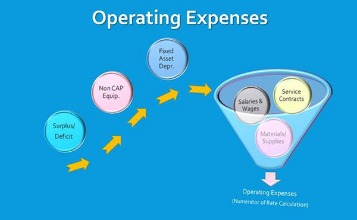Content

It can reveal the top performers within an industry and indicate the need for further research regarding why a particular company is outperforming or falling behind its peers. For example, a company with a ratio of 8% whose competitors average more than 10% may be at more financial risk than another company with the same ratio whose competitors average 7%. Start learning these skills today with Forage’s finance and accounting virtual experience programs. The Ascent is a Motley Fool service that rates and reviews essential products for your everyday money matters.
- With that said, operating income is the remaining earnings once all expenses related to core operations are accounted for (i.e. inclusive of both COGS and OpEx).
- It is the ratio of operating profits to revenues for a company or business segment.
- You calculate a company’s operating profit by adding to the cost of goods sold the rest of the expenses involved directly in the business, and subtracting the result from revenues.
- Some businesses, like grocery stores, tend to naturally have thinner margins, while others have fatter margins.
- Can better stand alone as a ratio to evaluate a company in totality.Because it’s a conclusive ratio, if any ratio goes wrong, or if anything goes wrong with the company, this ratio will be affected.
Only good as a supplementary ratio and is not comprehensive enough to stand alone. In terms of operating margin, the worst sector right now is Energy. As of September 2020, Energy has an operating margin of -3.2%, which is historically weak. It makes sense however, considering how battered that sector has been due to the COVID-19 pandemic.
Overview: What is operating margin?
Our writing and editorial staff are a team of experts holding advanced financial designations and have written for most major financial media publications. Our work has been directly cited by organizations including MarketWatch, Bloomberg, Axios, TechCrunch, Forbes, NerdWallet, GreenBiz, Reuters, and many others. Go a level deeper with us and investigate the potential impacts of climate change on investments like your retirement account.
What is an operating margin ratio?
It is the ratio of operating profits to revenues for a company or business segment. Expressed as a percentage, the operating margin shows how much earnings from operations is generated from every $1 in sales after accounting for the direct costs involved in earning those revenues.
In 2013 she transformed her most recent venture, a farmers market concession and catering company, into a worker-owned cooperative. She does one-on-one mentoring and consulting focused on entrepreneurship and practical business skills.
How Is Operating Profit Margin Calculated?
There is no standard for a good or bad ROE, but a higher ROE is better. Profit margin is net income divided by sales, measuring the percent of each dollar in sales that is profit for the company. This ratio measures how much each dollar in asset generates in sales. A higher ratio means that each dollar in assets produces more for the company. The ROA is the product of two other common ratios – profit margin and asset turnover.
S&P 500 earnings beats hit a 15-year low. More cost cuts are coming as companies play defense on profit margins – CNBC
S&P 500 earnings beats hit a 15-year low. More cost cuts are coming as companies play defense on profit margins.
Posted: Wed, 22 Feb 2023 19:52:02 GMT [source]
Additionally, the gross margin ratio includes all sales revenue, while the operating margin ratio only considers revenue from operations. Start your analysis of a company’s profitability by examining its gross margin. This figure reveals how inexpensively a company can manufacture or acquire the goods it sells to customers. For a retail company, cost of goods sold is the amount it pays to suppliers for the products that stock its shelves. Using a company’s income statement, you can calculate gross profit from these variables, as shown in Example 4-43. Emily’s Electronics’ sample income statement below shows annual revenue of $270,000 and $120,000 in COGS, leaving a gross profit of $150,000.
Operating Margin vs. Net Profit Margin
Understanding how to calculate profit margins is a core responsibility of accountants and many other finance professionals. Profit margins are an easy way to determine if a company is profitable and can inform investing decisions and help with crafting budgets. Knowing your operating margin is helpful, but it doesn’t include every expense a company bears. For instance, interest income and expenses aren’t included in operating income, though they are included in operating cash flow. In simpler terms, operating margin measures the profitability of a company by determining how much of each dollar of revenue received is left over after certain expenses are paid. Operating Profit margin is a ratio which measures profitability and the efficiency for controlling the cost and expenses related to the operations of the business. Breaking ROE into parts allows us to understand how and why it changes over time.
How Is Operating Margin Different From Other Profit Margin Measures?
Operating margin takes into account all operating costs but excludes any non-operating costs. Net profit margin takes into account all costs involved in a sale, making it the most comprehensive and conservative measure of profitability. Gross margin, on the other hand, simply looks at the costs of goods sold (COGS) and ignores things such as overhead, fixed costs, interest expenses, and taxes.
So you should mention on your resume if you have coursework, past work experience, or internships that worked on Determine Operating Profit Margin Ratios valuation or tracking companies’ profitability. In the description of the job or internship, you could mention “calculated profit margins for company worth $X amount” or that you calculated and compared profit margins for companies across various industries. It looks at how much the company makes per $1 of revenue generated. Or, to put it another way, a profit margin shows how much revenue a company can keep as profit. For example, a 60% profit margin would mean a company had a profit of $0.60 for every dollar of revenue generated.
How to Determine Changes in Operating Working Capital
To determine the gross profit margin, we need to divide the gross profit by the total revenue for the year and then multiply by 100. For example, the same T-shirt company from before also pays for warehouse space, advertisements, and small business loan payments. So, the net profit would be how much is left over after all of that is covered. To find the net profit margin, you divide the net income by total revenue, creating a ratio.
The https://intuit-payroll.org/ excludes the costs of financing and therefore can be used as a way to determine how much financing, if any, can be used by the company to grow. If operating profit margin is too low, financing might not be a suitable option to expand the business and it could suggest that some other form of investment will be required to expand. For instance, a company with an operating margin ratio of 20 percent means that for every dollar of income, only 20 cents remains after the operating expenses have been paid. This also means that only 20 cents is left over to cover the non-operating expenses.
Operating Profit Margin Ratio Formula and Uses
Revenue is how much money was generated by the company by selling products, goods, or services. Operating margin is used to determine the profitability of a business by measuring how much a company earns from sales-related activity.
Operating profit margin is a concise measure of how much your company actually earns at the end of the day. It is expressed as a percentage, showing what portion of your company’s revenue actually qualifies as income versus how much you’ve spent to keep your business running. This margin is a useful snapshot that shows how well you’re doing, and how this year’s numbers compare to past performance and future projections. With that said, operating income is the remaining earnings once all expenses related to core operations are accounted for (i.e. inclusive of both COGS and OpEx).
